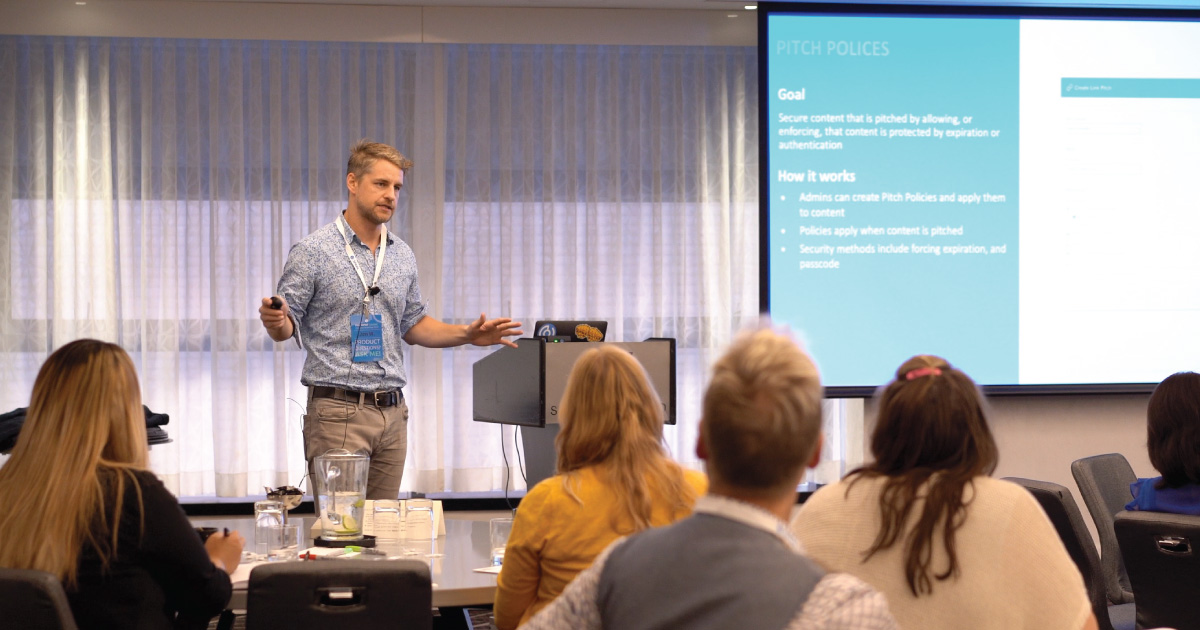ABC: The motivational sales shorthand for “Always Be Closing” might as well also stand for “Always Be Communicating,” because sales runs on communication. From opening pitch to closing deal, effective communication supports every step in the buyer’s journey and provides a critical link between sellers and internal teams such as marketing.
But sales communication can be a double-edged sword. While its importance in providing sales with critical connections is undeniable, it has the potential to overwhelm or distract sellers from their goals if there is no strategy guiding it. Quality, not quantity, is the key for sales leaders looking to create effective sales communication strategies for their teams. After all, sending more email updates won’t make your sales team any more informed if they aren’t finding the content relevant, valuable, or easily accessible. The guiding goal of any successful sales communication strategy should be to provide salespeople with the right information, in the right place, and at the right time.
Read on for the who, what, when, where, how, and why of developing a sales communication strategy. With these best practices, you’ll have a framework for communicating with your sales team that will keep them informed, prepared, and focused on the goals that matter.
These six steps will get you started:
- Define what is sales communication
- Show why sales communication is important
- Outline who is involved in sales communication
- Create a cadence of when sales communication happens
- Craft how sales communication gets delivered across different media
- Decide where sales communication happens
1. What is sales communication?
Sales communication is the process and messaging that keep sales teams informed, engaged, and productive while encouraging their feedback. In some companies, sales communication is a centralized function that acts as editor-in-chief and publisher for all messaging that goes to the sales team.
Whether you have a separate function dedicated to sales communication or not, the key to any successful sales communication strategy is to construct it like the foundation of a house. Strong sales communication fits naturally into the workflow of your sales team to keep them well-prepared and informed without wasting their time. As you begin to scope your strategy, you may want to conduct an audit of current sales communication practices and gather feedback from sales reps. Define efficiency and effectiveness metrics to establish a baseline. Your primary aim should be to create a sales communication strategy that has these two goals:
- Reduces the amount of time it takes to create and consume sales communications
- Improves understanding, retention, and following of sales communications
2. Why is sales communication important?
Creating a sales communication strategy is important because it establishes guidelines to keep sales reps informed of product changes, company news, or industry trends and guards against communication requiring reps to waste time sifting through internal resources or hunting down missing information.
As you begin to outline your sales communication strategy, keep in mind why it’s important. Having the big picture in mind will help you later explain and justify the decisions you’ve made to sales reps and other stakeholders. Once they understand the rationale behind the strategy, they’ll be more likely to participate and give you buy-in, which greatly improves the chances that your strategy will succeed.
Sales communication itself should also always show why it’s important by relating back to overarching sales themes and company goals. No matter the communication channel, these themes and goals should appear across media in a variety of forms — whether they’re newsletters, company intranet pages, email subject lines, weekly calls, coaching huddles, and other sales communication media.
3. Who is involved in sales communication?
An effective sales communication strategy should define owners for different channels and set processes in place to collect and disseminate information from sources other than these channel owners. Occasionally, subject matter experts such as executives, product managers, or partners could contribute directly by speaking on relevant topics during sales meetings.
If you’re defining communication strategy ownership for the first time, you may at first encounter resistance from those who have gotten used to communicating with the sales team directly without any limitations. This will require you to get their agreement on the rules of engagement laid out in your strategy. Take care to underscore why you created these guidelines: not to stop the flow of information, but to control and coordinate it to make it easier for sales reps to digest.
To make it easier to categorize and prioritize messaging, every communication request should contain these components:
-
- Source: The creator of the communication request, but not necessarily the final sender. For example, the chief sales officer may initiate a communication, but first-line sales managers deliver it to reps during weekly meetings. The source should not solely determine whether and how information gets delivered to the sales team.
-
- Audience: The primary intended audience. For example, both the sales team and service team may receive a communication about software revisions, but the information only impacts the work of the service team, which is the primary audience. The intended audience can determine priority and delivery. If the sales team is not the primary intended audience for a communication, then the information should arrive via a less direct messaging method, such as a sales enablement platform where reps can review news at their convenience without having to sift through their email inbox.
-
- Purpose: Communication should always meet a specific goal, align to sales themes, and contain a deadline if possible. An email about a new sales training class may be informative and relevant, but if its purpose is to order reps to take the class and earn certification by a specific date, it needs to be clearly communicated.
- Immediacy: The urgency of a communication. Does the sales force need to know this information immediately, or can it wait? This can inform when and how the sales team receives the communication.
4. When does sales communication happen?
Sales communication happens on daily, weekly, monthly, quarterly, and yearly cycles, and the content and delivery channels should change to reflect the different timescales and priority level. Broadly, sales communication should correlate with the rhythm of the business and support company goals.
As you define your sales communication strategy, decide on a regular cadence of communication with the sales team that takes urgency into account and routes to the appropriate delivery channel. Common communication cadences and channels are as follows:
-
- Daily: The most common daily sales communication channel is email; 70% of organizations that SiriusDecisions surveyed use email to provide reps with both core and non-core selling information. The problem with email is that it does not communicate priority very well. Every email, whether it’s a time-sensitive notification of a buyer’s trigger event or an invitation to next month’s company outing, carries the same weight.
-
- Weekly: The live all-sales meeting is the most popular weekly communication vehicle, according to SiriusDecisions, with 37% of survey respondents reporting that they hold weekly meetings. Weekly sales meetings often include pipeline reviews, important industry or company news updates, and team-building and cheerleading content. They’re also effective as vehicles for information from different sources in the form of guest speakers or presentations. The tradeoff is that weekly meetings require a non-insignificant amount of time and space, and traveling reps miss out on content and discussions.
-
- Monthly: Monthly communications are likely a good fit for channels that allow for asynchronous engagement, such as video, social, and mobile-oriented content that can be consumed anytime and across different devices. Organizations that cite video roleplay as a highly effective training delivery method report a 57% higher rate of rep quota achievement, says SiriusDecisions.
-
- Quarterly: Messaging delivered quarterly or less frequently tends to be event-oriented. Podcasts lead the category at 13% of SiriusDecisions survey respondents. Unlike email or live meetings, recorded videos and podcasts can be available for sales reps instantly at a point of need, depending on the progression of their buyers’ journeys.
-
- Annual: Annual communication tends to focus on sales plan elements including coverage models, quota assignments, and compensation plans. They are best delivered through a cascade of messaging that ensures consistency but still allows for dialogue.
- All of the above: Sales enablement platforms allow for asynchronous sales communication, content consumption, and activity-based enablement. They fit into the daily cadence of individual reps’ workflows without cluttering inboxes or interrupting learning and selling processes.
5. How should sales communication get delivered?
Sales communication delivery should differ depending on content, urgency, and priority. These elements will determine the channel of communication and the cadence used to inform the sales team. A sales communication strategy provides guidelines on the channels and cadences for delivering information.
Some of the most common form of sales communications include:
-
- Electronic newsletter: Often delivered to sales reps at a set frequency, typically weekly or biweekly, on a particular day and time. You’ll want to establish a publishing calendar specifying the contents of every issue with deadlines for contributor submissions, and use a marketing automation platform to track engagement and gauge effectiveness. Create a mobile-friendly template and stick to it so sales reps become can familiar with the layout and navigate it quickly and easily. Keep articles short with descriptive titles and subheadings, and insert a mix of media to accommodate different preferences for consuming information.
-
- Web conferencing session: A regularly scheduled web conference can replace or complement the electronic newsletter. It should last less than an hour (30 minutes is ideal). Like the newsletter, it should employ a consistent format and include visuals and other interactive elements, such as chat, polls, and Q&A. Make sure to record it so that reps who missed it can watch it later.
-
- Video and audio broadcast: Communications delivered via video and audio on a biweekly, monthly, or quarterly basis. They’re sometimes used to augment the newsletter or web conference and can allow reps to listen while driving. Keep them short (15 to 30 minutes) and use a talk-show format to make them engaging.
-
- Internal social platform: Social communication tools such as Chatter, Jive, Yammer, or Slack can augment other sales communications and deliver specific types of information, such as competitive intelligence. They provide the ability to search and create a communications history.
- First-line managers: Sales managers can deliver information one-on-one or as part of regularly scheduled sales meetings and can facilitate dialogue or gather feedback from reps. Encourage managers to call on reps during sales meetings to provide a summary of key messages and test for comprehension and compliance.
6. Where should sales communication primarily happen?
A successful sales communication strategy should provide the sales team with a solution that fits into their workflow and naturally draws their attention to the information they need when they need it. A sales enablement platform like Highspot can accomplish this task effectively.
Unlike other sales communication solutions and channels, a sales enablement platform provides the just-in-time information your sales team needs without cluttering their inbox or distracting from their sales workflows. Here are some of the reasons to incorporate a sales enablement tool into your sales communication strategy:
- Delivers communications where sales reps spend their time without compromising their ability to find correspondence with prospects easily
- Provides analytics to measure engagement with sales communications to identify who is reading them and who is not
- Encourages sales and marketing to work together to manage content, pitch and message buyers, and collaborate on projects
- Offers ability to communicate priority and urgency through dynamic layouts and eye-catching design that drives higher engagement rates
- Intelligently integrates with other sales tools to customize experience based on what sales reps are trying to accomplish at any point in time; for example, could highlight opportunities in Salesforce at different stages and provide relevant information on next steps
- Coordinates and manages incoming communications so that sales reps get the information they need and don’t need to dig through internal messages to get critical information
Analysts also recognize the advantages of placing sales communications within a sales enablement function. For example, SiriusDecisions recommends creating a “centralized sales communications function that acts as editor-in-chief and publisher,” with guidelines and governance policies that make it clear that all communications to the field force must be channeled through this function. “We see this function residing with sales enablement,” SiriusDecisions concludes.
Now that you’ve defined the who, what, when, where, how, and why of your sales communication strategy, you may think that your work here is done. But it’s not — and it may never be! A successful sales communication strategy should evolve to meet the changing needs of your sellers and their buyers. Be sure to regularly gather comments from sales reps, marketers, and other internal stakeholders. With their feedback, you’ll be able to keep a pulse your sales communications strategy and gain valuable insight into how to continue improving it, leading to even better sales communications in the future.
Learn more about how Highspot can strengthen your sales communication strategy and take a demo today.





